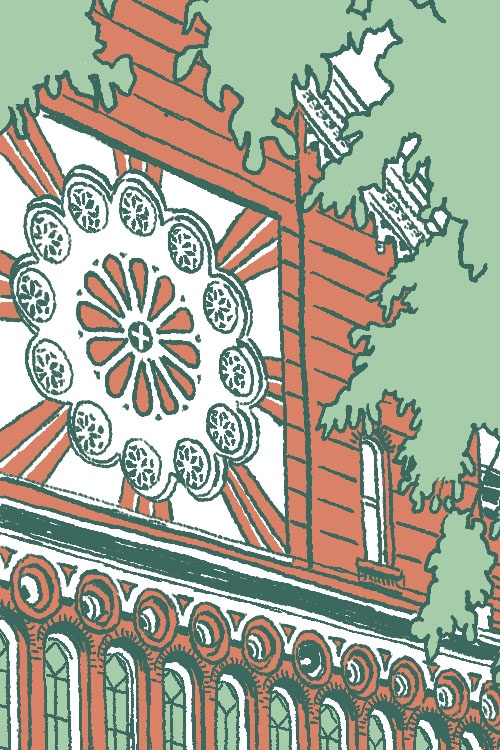 Illustration by Sophie Lafleur
Illustration by Sophie Lafleur
Back to Church
It’s Sunday morning, and Marché Jean-Talon is bursting at its seams. Scores of suburbanites arrive in their bulky SUVs and queue along Avenue Henri-Julien for the underground parking. I escape the pandemonium with my sack of vegetables as an elderly Italian woman rolls a wheeled shopping bag between the vendors’ stalls. Short but stout, she wrestles men twice her size out of her path as she handles bunches of parsley and rapini. She’s one of the true veterans: the final vestige of immigrants who never left the tight grid of low-rise apartments between Saint-Laurent and Saint-Denis.
I grew up a little ways away, at the eastern end of Rue Saint-Zotique, surrounded by the descendants of Italian immigrants who believed moving away from their first stomping ground meant they’d move up in status. Others stayed behind, laughing atop their real estate goldmines after the buildings rocketed in value. When I walk past Caffè Italia or Caffè San Simeon, I see the same group of older men judging young hipsters, cackling at the counter in their Napulitan’ dialect. They sit there for hours, almost to remind the newcomers who was here first, back when this stylish quartier was nothing but an Italian ghetto by the railroad tracks.
Now I reside at the western end of Saint-Zotique, just a few hundred steps from where my grandmother, Nonna Carmela Parente, lived after she landed in Canada as a teen in 1953. Her family’s first apartment building still stands on Avenue de Gaspé, three tiny stories with the same red brick and crooked balconies. A small iron staircase spirals down the side into a tiny courtyard. How many times did she festoon the square with clotheslines of damp laundry, or hop down the steps on her errand run to the paesano butcher or grocer?
In the mid-sixties, my newlywed nonna moved east to Saint-Michel. She never spoke directly of her adolescence south of the market, but alluded to that era with forlorn fondness. It’s that nostalgic sense of simple, humble living that ignited my determination to move to the area. But her Little Italy was another world entirely. The streets are lined with the same facades, yet the buildings are now stuffed with vintage clothes, organic soaps and yoga mats. I wonder if my nonna would’ve waded through tourists for some cannoli at Pasticceria Alati-Caserta, or been peeved by the pricey imports at Fruiterie Milano.
The bohemian twenty-somethings and old-school macho men make me uncomfortable in equal measure, so I usually take refuge at Café Ferlucci. The owner is an old schoolmate, another Italian scion of the East End. She opened the coffee shop in an old hattery and cobblery, and keeps the original tools hanging from the walls. The interior remains unaltered: its panels are peeling and dirty, its decor rusty and dusty. Did Nonna Carmela’s father sip espresso here while getting his fedora fitted before heading to church? I’d like to believe that could be true.
I can see Madonna della Difesa Church from my apartment window. It towers over all the other buildings in its vicinity, like a vigilant parent watching over its children. My grandparents married there, my parents as well. And although I doubt my partner and I will continue that particular tradition, living beneath the church’s motherly shadow rekindles another: I light a prayer candle for nonna at every Sunday mass.
In the years before she died, my grandmother never set foot in the old neighbourhood. I’m still unsure what she’d think of Little Italy today, of her grandson meandering shoulder to shoulder with bourgeois francophones and student anglophones. Would she be proud as I try to relive some smidge of her origin story, or outraged at how much I pay in rent? It’s tough to say.
But I imagine the old Italian woman from the market, wheeling her shopping bag onto the front step of a little duplex. Her second homeland changes with each passing year, and yet she withstands the winds of time. ⁂
Anthony Portulese is an emerging Italo-Québécois writer living in Montreal. You can likely find him tucked away in a corner of a cafe, working to finish his first novel.





